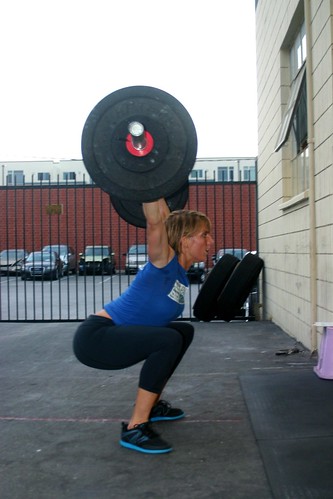Ghost of Christmas Future
Friday, December 23, 2011
Warm Up
2 Rounds for Quality of:
100 single unders while jogging in place
15 Sumo Deadlift High pulls, 35lb kettlebell
10 Basic Dot Drills
40′ Bear Crawl
Rest as needed, then perform
Three rounds for time of:
Row 1000 meters
Run 800 meters
We are going to try something new today. We will stagger start the heats as usual, but if there are any bottlenecks on the rower, the athlete will perform as many sumo deadlift high pulls as possible while waiting for a rower to open. For every SDHP they perform, that will count as 10 meters on the rower.
So if you perform 50 SDHPs that means you would only have to row 500 meters. There is a maximum of 100 SDHPs! The standard weight will be 45lbs for everyone, but scaleable if necessary.
Cool Down
For Quality:
Calf stretch for 1:00 each leg
Foam Roll your upper back for 2:00
30 Overhead Squats with PVC pipe, work hard to stay as vertical as possible with the armpits forward (read below, this should be hard for most of you)
Take a look at these two pictures above. What is the first thing that stands out to you in the differences of position?
Go ahead, list everything different you can see, I’ll wait..
Done? Ok.
First, let me admit that Martina on the left is doing overhead squats, while the girl on the right is performing a squat snatch. Otherwise, check out the angle of the torso and the relationship to the arm and shoulder. Look at the angle of the ankle and the relationship to the hip.
Martina is performing an average CrossFit style overhead squat, and we are happy with her position: below parallel, weight in the heels, back flat with neutral spine, weight over the middle of the foot, arms locked out, beautiful! So what about this mystery Olympic lifting lady on the right? She also satisfies all of these requirements, yet she is in a more structurally sound position. Coach Burgener calls this “stacking the bones,” meaning the weight is supported by the wrists, which are over the shoulders which are over the scapula, over the hips over the ankles. While Martina is balanced over the middle of her foot, the weight can be seen as ‘floating’ over air in comparison.
I bring this up for a few reasons. First, is that we don’t necessarily teach the overhead squat and snatch this way. Second, I suck at the overhead squat and snatch (and I know I’m not the only one) and have been searching for ways to improve. Third, we have been doing a lot more mobility work lately and this fits right in.
Below I grabbed a few interesting notes on flexibility and the overhead squat from this article in Catalyst Athletics (thanks CF Pacific Coast):
Ankle flexibility is usually a limiting factor in a full-depth Olympic squat for individuals of any height…Also make sure to mobilize your thoracic spine. Often tightness and hyperkyphosis here will make the overhead position impossible…Shoulder flexibility itself I’ve found is often the least of people’s problems. They’re usually unable to sit into a full-depth upright squat, but then focus on the shoulders’ flexibility because they’re interested in holding a bar overhead. With the present amount of shoulder flexibility they have, if they can sit upright, they will be fine. If you can hold the bar overhead in the correct position when standing and with a forward lean of the torso of a few degrees, you have enough shoulder flexibility to overhead squat. If your shoulder range of motion seems to disappear as you squat, it’s coming more out of the squat than the shoulders.
Watch Burgener discuss the snatch position in the video below (I encourage you to watch the entire thing, but if you are in a hurry, start at minute 3:00)

















